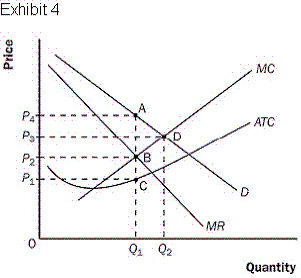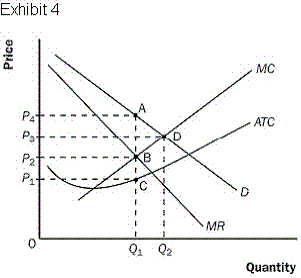True/False
Indicate whether the
statement is true or false.
|
|
|
1.
|
Monopolists are price takers.
|
|
|
2.
|
The most common source of a barrier to entry into a monopolist's market is
that the monopolist owns a key resource necessary for production of that good.
|
|
|
3.
|
A monopoly is the sole seller of a product with no close substitutes.
|
|
|
4.
|
A natural monopoly is a monopoly that uses its ownership of natural resources as
a barrier to entry into its market.
|
|
|
5.
|
The demand curve facing a monopolist is the market demand curve for its
product.
|
|
|
6.
|
For the monopolist, marginal revenue is always less than the price of the
good.
|
|
|
7.
|
The monopolist chooses the quantity of output at which marginal revenue equals
marginal cost and then uses the demand curve to find the price that will induce consumers to buy that
quantity.
|
|
|
8.
|
The supply curve for a monopolist is always positively sloped.
|
|
|
9.
|
A monopolist produces an efficient quantity of output but it is still
inefficient because it charges a price that exceeds marginal cost and the resulting profit is a
social cost.
|
|
|
10.
|
Using regulations to force a natural monopoly to charge a price equal to its
marginal cost of production will cause the monopoly to lose money and exit the industry.
|
|
|
11.
|
Most economists argue that the most efficient solution to the problem of
monopoly is that the monopoly should be publicly owned.
|
|
|
12.
|
Price discrimination is only possible if there is no arbitrage.
|
|
|
13.
|
Price discrimination can raise economic welfare because output increases beyond
that which would result under monopoly pricing.
|
|
|
14.
|
Perfect price discrimination is efficient but all of the surplus is received by
the consumer.
|
|
|
15.
|
Universities are engaging in price discrimination when they charge different
levels of tuition to poor and wealthy students.
|
Multiple Choice
Identify the
choice that best completes the statement or answers the question.
|
|
|
16.
|
Which of the following is not a barrier to entry in a monopolized market?
a. | A single firm is very large. | b. | The government gives a single firm the
exclusive right to produce some good. | c. | The costs of production make a single producer
more efficient than a large number of producers. | d. | A key resource is owned by a single
firm. |
|
|
|
17.
|
A firm whose average total cost continually declines at least to the quantity
that could supply the entire market is known as a
a. | regulated monopoly. | c. | government monopoly. | b. | perfect competitor. | d. | natural
monopoly. |
|
|
|
18.
|
When a monopolist produces an additional unit, the marginal revenue generated by
that unit must be
a. | above the price because the output effect outweighs the price
effect. | b. | below the price because the price effect outweighs the output
effect. | c. | above the price because the price effect outweighs the output
effect. | d. | below the price because the output effect outweighs the price
effect. |
|
|
|
19.
|
A monopolist maximizes profit by producing the quantity at which
a. | marginal cost equals price. | b. | marginal revenue equals
price. | c. | marginal revenue equals marginal cost. | d. | marginal cost equals
demand. | e. | marginal cost is minimised. |
|
|
|
20.
|
Which of the following statements about price and marginal cost in competitive
and monopolized markets is true?
a. | In competitive markets, price equals marginal cost; in monopolized markets, price
exceeds marginal cost. | b. | In competitive markets, price equals marginal
cost; in monopolized markets, price equals marginal cost. | c. | In competitive
markets, price exceeds marginal cost; in monopolized markets, price exceeds marginal
cost. | d. | In competitive markets, price exceeds marginal cost; in monopolized markets, price
equals marginal cost. |
|
|
|
21.
|
Cengage is a monopolist in the production of your textbook because
Cengage:
a. | is a very large company. | b. | owns a key resource in the production of
textbooks. | c. | is a natural monopoly. | d. | has a legally protected exclusive right to
produce this textbook. |
|
|
|
22.
|
Refer to Exhibit 4. The profit-maximizing monopolist will choose the price and
quantity represented by point 
a. a. | b. | c. | d. | b. | c. | d. | e. none of these
answers |
|
|
|
23.
|
Refer to Exhibit 4. The efficient price and quantity are represented by
point  a. | A
b.
D
c. B | b. | C | c. | none of these
answers. |
|
|
|
24.
|
The inefficiency associated with monopoly is due to
a. | the monopoly's profits. | c. | the monopoly's
losses. | b. | underproduction of the good. | d. | overproduction of the
good. |
|
|
|
25.
|
Compared to a perfectly competitive market, a monopoly market will usually
generate
a. | lower prices and lower output. | c. | higher prices and lower
output. | b. | higher prices and higher output. | d. | lower prices and higher
output. |
|
|
|
26.
|
The monopolist's supply curve
a. | is the upward-sloping portion of the average variable cost. | b. | is the marginal cost
curve above average variable cost. | c. | is the marginal cost curve above average total
cost. | d. | is the upward-sloping portion of the average total cost curve. | e. | does not
exist. |
|
|
|
27.
|
Using government regulations to force a natural monopoly to charge a price equal
to its marginal cost will
a. | improve efficiency. | b. | cause the monopolist to exit the
market. | c. | raise the price of good. | d. | attract additional firms to enter the
market. |
|
|
|
28.
|
The purpose of antitrust (also known as competition) laws is to
a. | Ensure prices are the same for all consumers | b. | regulate the prices
charged by a monopoly. | c. | increase merger activity to help generate
synergies that reduce costs and raise efficiency. | d. | create public ownership of natural
monopolies. | e. | increase competition in an industry by preventing mergers and breaking up large
firms. |
|
|
|
29.
|
Public ownership of natural monopolies
a. | creates synergies between the newly acquired firm and other government-owned
companies. | b. | usually lowers the cost of production dramatically. | c. | tends to be
inefficient. | d. | does none of the things described in these answers. |
|
|
|
30.
|
Which of the follow statements about price discrimination is not true?
a. | Price discrimination increases a monopolist's profits. | b. | Price discrimination
can raise economic welfare. | c. | Price discrimination requires that the seller
be able to separate buyers according to their willingness to pay. | d. | Perfect price
discrimination generates a deadweight loss. | e. | For a monopolist to engage in price
discrimination, buyers must be unable to engage in arbitrage. |
|
|
|
31.
|
If regulators break up a natural monopoly into many smaller firms, the cost of
production
a. | will remain the same. | b. | will fall. | c. | will
rise. | d. | could either rise or fall depending on the elasticity of the monopolist's supply
curve. |
|
|
|
32.
|
A monopoly is able to continue to generate economic profits in the long run
because
a. | It can control both price and output in the market. | b. | potential
competitors sometimes don't notice the profits. | c. | the monopolist is financially
powerful. | d. | antitrust laws eliminate competitors for a specified number of
years. | e. | there is some barrier to entry to that market. |
|
|
|
33.
|
If marginal revenue exceeds marginal cost, a monopolist should
a. | raise the price. | b. | decrease output. | c. | keep output the same
because profits are maximized when marginal revenue exceeds marginal cost. | d. | increase
output. |
|